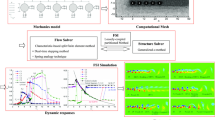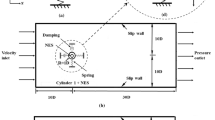Abstract
To explore the relationship between dynamic characteristics and wake patterns, numerical simulations were conducted on three equal-diameter cylinders arranged in an equilateral triangle. The simulations varied reduced velocities and gap spacing to observe flow-induced vibrations (FIVs). The immersed boundary–lattice Boltzmann flux solver (IB – LBFS) was applied as a numerical solution method, allowing for straightforward application on a simple Cartesian mesh. The accuracy and rationality of this method have been verified through comparisons with previous numerical results, including studies on flow past three stationary circular cylinders arranged in a similar pattern and vortex-induced vibrations of a single cylinder across different reduced velocities. When examining the FIVs of three cylinders, numerical simulations were carried out across a range of reduced velocities (3.0 ⩽ Ur ⩽ 13.0) and gap spacing (L = 3D, 4D, and 5D). The observed vibration response included several regimes: the desynchronization regime, the initial branch, and the lower branch. Notably, the transverse amplitude peaked, and a double vortex street formed in the wake when the reduced velocity reached the lower branch. This arrangement of three cylinders proved advantageous for energy capture as the upstream cylinder’s vibration response mirrored that of an isolated cylinder, while the response of each downstream cylinder was significantly enhanced. Compared to a single cylinder, the vibration and flow characteristics of this system are markedly more complex. The maximum transverse amplitudes of the downstream cylinders are nearly identical and exceed those observed in a single-cylinder set-up. Depending on the gap spacing, the flow pattern varied: it was in-phase for L = 3D, antiphase for L = 4D, and exhibited vortex shedding for L = 5D. The wake configuration mainly featured double vortex streets for L = 3D and evolved into two pairs of double vortex streets for L = 5D. Consequently, it well illustrates the coupling mechanism that dynamics characteristics and wake vortex change with gap spacing and reduced velocities.
Similar content being viewed by others
References
Alam MM, Elhimer M, Wang L, Jacono DL, Wong CW (2018) Vortex shedding from tandem cylinders. Experiments in Fluids 59(3): 60. https://doi.org/10.1007/s00348-018-2501-8
Bearman P (2011) Circular cylinder wakes and vortex-induced vibrations. Journal of Fluids and Structures 27(5–6): 648–658. https://doi.org/10.1016/j.jfluidstructs.2011.03.021
Chen LF, Wu GX (2020) Flow-induced transverse vibration of a circular cylinder close to a plane wall at small gap ratios. Applied Ocean Research 103: 102344. https://doi.org/10.1016/j.apor.2020.102344
Chen W, Ji CN, Williams J, Xu D, Yang LH, Cui YT (2018) Vortex-induced vibrations of three tandem cylinders in laminar cross-flow: vibration response and galloping mechanism. Journal of Fluids and Structures 78: 215–238. https://doi.org/10.1016/j.jfluidstructs.2017.12.017
Chen XY, Zha GC (2010) Fully coupled fluid-structural interaction in a hybrid Cartesian-body fitted grid system. Computational Mechanics 46 (1): 3–16. https://doi.org/10.1007/s00466-009-0421-4
Chen Z, Alam MM, Qin B, Zhou Y (2020) Energy harvesting from and vibration response of different diameter cylinders. Applied Energy 278: 115737. https://doi.org/10.1016/j.apenergy.2020.115737
Fan X, Wang Z, Chen X, Wang Y, Tan W (2020) Experimental investigation on flow-induced vibration of flexible multi cylinders in atmospheric boundary layer. International Journal of Mechanical Sciences 183: 105815. https://doi.org/10.1016/j.ijmecsci.2020.105815
Favier J, Revell A, Pinelli AA (2014) Lattice Boltzmann-immersed boundary method to simulate the fluid interaction with moving and slender flexible objects. Journal of Computational Physics 261: 154–161. https://doi.org/10.1016/j.jcp.2013.12.052
Giannopoulou O, Colagrossi A, Di Mascioc A, Mascia C (2019) Chorin’s approaches revisited: vortex particle method vs finite volume method. Engineering Analysis with Boundary Elements 106: 371–388. https://doi.org/10.1016/j.enganabound.2019.05.026.
Han X, Lin W, Qiu A, Feng Z, Wu J, Tang Y, Zhao C (2019) Understanding vortex-induced vibration characteristics of a long flexible marine riser by a bidirectional fluid-structure coupling method. Journal of Marine Science and Technology 25: 620–639. https://doi.org/10.1007/s00773-019-00663-y
Haussmann M, Hafen N, Raichle F, Trunk R, Krause, MJ (2020) Galilean invariance study on different lattice boltzmann fluid-solid interface approaches for vortex-induced vibrations. Computers & Mathematics with Applications 80(5): 671–691. https://doi.org/10.1016/j.camwa.2020.04.022
Ji J, Chen W, Gao R, Liu B, Zhang J (2020) Research on vibration and heat transfer in heat exchanger with vortex generator. Journal of Thermophysics and Heat Transfer 6: 1–7. https://doi.org/10.2514/1.T6081
Kang SK (2010) Immersed boundary methods in the lattice Boltzmann equation for flow simulation. PhD thesis, Texas A&M University, Texas
Laborderie JD, Duchaine F, Gicquel L, Vermorel O, Wang G, Moreau S (2018) Numerical analysis of a high-order unstructured overset grid method for compressible les of turbomachinery. Journal of Computational Physics 363: 371–398. https://doi.org/10.1016/j.jcp.2018.02.045
Li D, Wu Y, Ronch AD, Xiang J (2016) Energy harvesting by means of flow-induced vibrations on aerospace vehicles. Progress in Aerospace Sciences 86: 28–62. https://doi.org/10.1016/j.paerosci.2016.08.001
Luo LS, Liao W, Chen X, Peng Y, Zhang W (2011) Numerics of the lattice Boltzmann method: effects of collision models on the lattice Boltzmann simulations. Physical review E 83(5): 056710. https://doi.org/10.1103/PhysRevE.83.056710
Luo ZM, Zhang LX (2015) Force characteristics and hydrokinetic energy harvesting for VIV of four coupling-linked cylinders. Journal of Vibration and Shock 34(17): 25–29. https://doi.org/10.13465/j.cnki.jvs.2015.17.005
Ma YX, Xu WH, Liu B (2019) Dynamic response of three long flexible cylinders subjected to flow-induced vibration (FIV) in an equilateral-triangular configuration. Ocean Engineering 183: 187–207. https://doi.org/10.1016/j.oceaneng.2019.04.096
Mohanty A, Parida S, Behera RK, Roy T (2019) Vibration energy harvesting: A review. Journal of Advanced Dielectrics 9(4): 1–17. https://doi.org/10.1142/S2010135X19300019
Rabiee AH, Barzan MR, Mohammadebrahim A (2021) Flow-induced vibration suppression of elastic square cylinder using windward-suction-leeward-blowing approach. Applied Ocean Research 109: 102552. https://doi.org/10.1016/j.apor.2021.102552
Shu C, Wang Y, Teo CJ, Wu J (2014) Development of lattice Boltzmann flux solver for simulation of incompressible flows. Advances in Applied Mathematics and Mechanics 6(4): 436–460. https://doi.org/10.4208/aamm.2014.4.s2
Singh SP, Mittal S (2005) Vortex-induced oscillations at low Reynolds numbers: hysteresis and vortex-shedding modes. Journal of Fluids and Structures 20(8): 1085–1104. https://doi.org/10.1016/j.jfluidstructs.2005.05.011
Song H, Huang W, Chang S (2020) Empirical model for wake induced vibrations frequency response of cylinder with low mass ratio. Ocean Engineering 195: 106746. https://doi.org/10.1016/j.oceaneng.2019.106746
Suzuki K, Inamuro T (2011) Effect of internal mass in the simulation of a moving body by the immersed boundary method. Computers and Fluids 49(1): 173–187. https://doi.org/10.1016/j.compfluid.2011.05.011
Tan Q, Fan K, Guo J, Wen T, Zhou S (2021) A cantilever-driven rotor for efficient vibration energy harvesting. Energy 235: 121326. https://doi.org/10.1016/j.energy.2021.121326
Vahdati M, Lee KB, Sureshkumar P (2020) A review of computational aeroelasticity of civil fan blades. International Journal of Gas Turbine 11(4): 22–35. https://doi.org/10.38036/jgpp.11.4_22
Wang JS, Fan D, Lin K (2020) A review on flow-induced vibration of offshore circular cylinders. Journal of Hydrodynamics 32(5): 415–440. https://doi.org/10.1007/s42241-020-0032-2
Wang H, Yu G, Yang W (2013) Numerical study of vortex-induced vibrations of three circular cylinders in equilateral-triangle arrangement. Advances in Mechanical Engineering 5: 1–14. https://doi.org/10.1155/2013/287923
Wang Y, Shu C, Teo CJ, Wu J (2015) An immersed boundary-lattice Boltzmann flux solver and its applications to fluid-structure interaction problems. Journal of Fluids and Structures 54: 440–465. https://doi.org/10.1016/j.jfluidstructs.2014.12.003
Wu W, Wang J (2017) Numerical simulation of VIV for a circular cylinder with a downstream control rod at low Reynolds number. European Journal of Mechanics-B/Fluids 68: 153–166. https://doi.org/10.1016/j.euromechflu.2017.12.005
Wu XD, Chen F, Liu HP (2017) Combined immersed boundary method and MRT lattice Boltzmann flux solver for numerical simulations of incompressible flows. Applied Mathematics and Mechanics 38(12): 1679–1696. https://doi.org/10.1007/s10483-017-2290-7
Xu F, Xiao Y, Liu H, Ou J (2014) Numerical study on vortex-induced vibration of three cylinders in equilateral-triangular arrangements. Proceedings of the 2nd Symposium on Fluid-Structure-Sound Interactions and Control, 391–398. https://doi.org/10.1007/978-3-642-40371-2_56
Xu W, Zhang S, Ma Y, Liu B (2021) Fluid forces acting on three and four long side-by-side flexible cylinders undergoing flow-induced vibration (FIV). Marine Structures 75: 102877. https://doi.org/10.1016/j.marstruc.2020.102877
Yang X, Ji C, Chen W, Zhang Z (2019) Wake patterns and hydrodynamic forces of flow around circular cylinders in an equilateral triangular arrangement. Journal of Hydrodynamics Ser. A 34(1): 69–76. https://doi.org/10.16076/j.cnki.cjhd.2019.01.009
Zhang AM, Li SM, Pu C, Li Shuai, Liu YL (2023) A unified theory for bubble dynamics. Physics of Fluids 35: 033323. https://doi.org/10.1063/5.0145415
Zhang B, Mao Z, Song B, Tian W, Ding W (2018) Numerical investigation on VIV energy harvesting of four cylinders in close staggered formation. Ocean Engineering 165: 55–68. https://doi.org/10.1016/j.oceaneng.2018.07.042
Zhou Y, Alam MM (2016) Wake of two interacting circular cylinders: a review. International Journal of Heat & Fluid Flow 62: 510–537. https://doi.org/10.1016/j.ijheatfluidflow.2016.08.008
Funding
Funding Supported by the National Natural Science Foundation of China (52201350, 52201394, and 52271301), and the Innovation Group Project of Southern Marine Science and Engineering Guangdong Laboratory (Zhuhai) (Grant No. SML2022008).
Author information
Authors and Affiliations
Corresponding author
Ethics declarations
Competing interest The authors have no competing interests to declare that are relevant to the content of this article.
Additional information
Article Highlights
• FIV of multiple cylinders can be simply solved by IBM-LBFS using Cartesian mesh.
• Transverse vibration response of downstream two cylinders in an equilateral-triangular configuration can be enhanced at 3D ⩽ L ⩽ 5D.
• Flow patterns of FIV in resonance region is similar to the state of flow past stationary equal-diameter cylinders in an equilateral triangle.
Rights and permissions
About this article
Cite this article
Wu, X., Li, J., Huang, S. et al. Flow-Induced Transverse Vibration of Three Equal-Diameter Cylinders in an Equilateral Triangle Using the Immersed Boundary–Lattice Boltzmann Flux Solver. J. Marine. Sci. Appl. (2024). https://doi.org/10.1007/s11804-024-00461-y
Received:
Accepted:
Published:
DOI: https://doi.org/10.1007/s11804-024-00461-y




